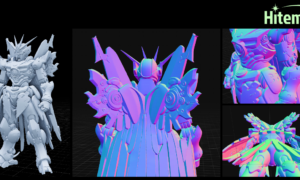Are you tired of carrying around heavy hardcovers but not ready to abandon the charm of printed books entirely? Introducing the hybrid e-book, a perfect blend of traditional reading and modern convenience. In this in-depth guide, we will explore the fascinating world of hybrid e-books, uncovering their advantages, disadvantages, and everything in between. Whether you’re an avid book lover or a tech-savvy reader eager to explore new horizons, join us as we unravel the mysteries behind this innovative literary phenomenon. Get ready to embark on an electrifying journey that combines the best of both worlds—let’s dive into understanding the hybrid e-book!
What is a Hybrid E-Book?
A hybrid e-book refers to an electronic book that encompasses both traditional print book content and digital elements. These digital components can include audio, video, and interactive elements. Typically, hybrid e-books are published in formats compatible with dedicated e-reader devices and personal computers.
The term “hybrid e-book” encompasses various types of e-books that incorporate both traditional print content and digital features. These digital elements enhance the reading experience by providing additional information and multimedia elements. For instance, a history book may include video clips of interviews with people who lived through the events being described, while a science textbook could feature simulations or animations to illustrate key concepts.
Advantages of Hybrid E-Books
Publishing hybrid e-books comes with several advantages. The inclusion of digital content elevates the reading experience by offering supplementary information and multimedia elements. Readers can enjoy a more immersive experience with audio or video content that holds their attention for longer periods.
Another significant advantage is the ease of updating hybrid e-books compared to traditional print books. Digital content can be revised without the need to print new editions of the entire book, resulting in more up-to-date information for readers. This agility allows hybrid e-books to provide the most current knowledge on any given subject.
Benefits of a Hybrid E-Book
A hybrid e-book is an eBook that combines digital and print components, providing readers with a versatile reading experience. The benefits of a hybrid e-book are:
Increased Engagement: By incorporating multimedia elements, such as audio and video, hybrid e-books can enhance reader engagement. These additions create a more immersive experience that captivates readers for longer durations.
Enhanced Learning: The digital features in hybrid e-books allow for interactive learning experiences. Readers can interact with the content through quizzes, clickable elements, and multimedia presentations, resulting in a more effective and enjoyable learning process.
Accessible Anywhere: Hybrid e-books can be accessed on a variety of devices, including e-readers, tablets, smartphones, and computers. This accessibility allows readers to enjoy their books wherever and whenever they choose, eliminating the constraints of physical books.
Updatable Content: Unlike printed books, hybrid e-books can be easily updated to reflect new information or developments. Authors can seamlessly incorporate the latest findings, ensuring that readers have access to the most accurate and current knowledge.
How a Hybrid E-Book Works
A hybrid e-book combines traditional book content with enhanced digital elements. Typically, these e-books are published in PDF format, which is compatible with most computers, tablets, and smartphones.
The traditional book content in a hybrid e-book consists of the text itself, without any enhancements. This text can be extracted from the PDF to create an EPUB file suitable for most e-readers. However, it’s important to note that the traditional book content won’t include multimedia enhancements.
To access the multimedia elements in a hybrid e-book, you’ll need a program capable of viewing PDFs with multimedia elements, such as Adobe Acrobat Reader. Once installed, simply double-click the PDF file to open it. Inside Adobe Acrobat Reader, you’ll find embedded multimedia elements, which you can interact with or playback. For example, if the e-book includes an audio clip, you can listen to it directly within Adobe Acrobat Reader.
Creating a Hybrid E-Book
Creating a hybrid e-book allows you to tailor your reading experience by combining the best aspects of both traditional and digital formats. Here are some key considerations when creating your hybrid e-book:
Choose the format: Decide on the format for your e-book, such as PDF, EPUB, or MOBI. Each format has its advantages and disadvantages, so select the one that aligns with your needs.
Select a platform: Determine the platform on which you’ll publish your hybrid e-book. Popular options include the Kindle, Nook, iPad, Kobo, and Sony Reader. Research the pros and cons of each platform to make an informed choice.
Develop your content. Determine the format(s) your content will take, such as text, images, audio, or video. Organize your content effectively based on the size and complexity of your project.
Design the cover and layout: Consider designing a professional cover and layout for your hybrid e-book to enhance its visual appeal and professionalism.
Test your e-book: Before publishing, thoroughly test your hybrid e-book to ensure that all multimedia elements function properly across different devices and platforms.
Formatting Tips for Hybrid E-Books
Formatting a hybrid e-book can be a challenging task, but these tips can help you optimize your e-book for a seamless reading experience:
Use high-quality multimedia: Incorporate high-resolution images and videos to ensure a visually pleasing experience for readers.
Enable easy navigation: Organize your content with clear headings and subheadings, and consider adding an index or table of contents to facilitate easy navigation.
Prioritize readability: Choose a legible font and use appropriate spacing between paragraphs and lines of text to enhance readability.
Utilize whitespace effectively: Strategic use of whitespace can highlight important elements and break up long blocks of text, improving the overall visual appeal.
Thoroughly test your e-book: Before publishing, test your hybrid e-book on various devices and platforms to ensure a consistent and enjoyable reading experience for all readers.
How to Market Your Hybrid E-Book
Once you’ve created your hybrid e-book, it’s essential to effectively market it to reach your target audience. Here are some marketing strategies to consider:
Leverage social media: Promote your hybrid e-book on platforms like Twitter, Facebook, and Instagram. Share excerpts from your book, engage with your audience, and generate interest in your work.
Connect with bloggers and reviewers: Reach out to bloggers and book reviewers who focus on your book’s genre or topic. Offer them a complimentary copy in exchange for an honest review.
Organize talks and readings: Approach local libraries, bookstores, or literary events to secure opportunities for talks or readings from your hybrid e-book. This will help generate buzz and attract potential readers.
Participate in online communities: Join online forums and discussion groups related to your book’s topic. Engage with the community, offer valuable insights, and introduce your hybrid e-book when appropriate.
Conclusion
We hope this comprehensive guide has provided you with a thorough understanding of hybrid e-books and their benefits for readers. By combining the convenience of digital formats with the tactile appeal of print, hybrid e-books offer an unparalleled reading experience. Don’t hesitate to give them a try! With their unique features and advantages, we believe they are worth every penny. Embrace the hybrid e-book and embark on a literary journey that bridges the gap between tradition and innovation.



































